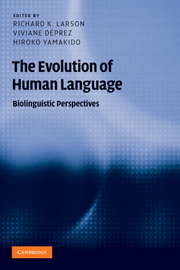Book contents
- Frontmatter
- Contents
- Figures
- Contributors
- Acknowledgments
- Introduction
- 1 The faculty of language: what is it, who has it, and how did it evolve?
- Part I Language architecture
- 2 Some simple evo devo theses: how true might they be for language?
- 3 Your theory of language evolution depends on your theory of language
- 4 Three meanings of “recursion”: key distinctions for biolinguistics
- 5 On obfuscation, obscurantism, and opacity: evolving conceptions of the faculty of language
- Part II Language and interface systems
- Part III Biological and neurological foundations
- Part IV Anthropological context
- Notes
- References
- Index
2 - Some simple evo devo theses: how true might they be for language?
Published online by Cambridge University Press: 05 June 2012
- Frontmatter
- Contents
- Figures
- Contributors
- Acknowledgments
- Introduction
- 1 The faculty of language: what is it, who has it, and how did it evolve?
- Part I Language architecture
- 2 Some simple evo devo theses: how true might they be for language?
- 3 Your theory of language evolution depends on your theory of language
- 4 Three meanings of “recursion”: key distinctions for biolinguistics
- 5 On obfuscation, obscurantism, and opacity: evolving conceptions of the faculty of language
- Part II Language and interface systems
- Part III Biological and neurological foundations
- Part IV Anthropological context
- Notes
- References
- Index
Summary
Study of evolution of some system is feasible only to the extent that its nature is understood. That seems close to truism. One could hardly investigate the evolution of the eye or of insect navigation knowing only that the eye is an “organ of sight” and that navigational skills are a way to return home. The same truism holds for inquiry into the evolution of human language – henceforth simply language. Accordingly, a sensible approach is to begin with properties of language that are understood with some confidence and seek to determine how they may have evolved, temporarily putting to the side others that are more poorly understood and the additional problems they might pose. I will try to outline such a course, keeping to a sketch of general directions, hoping at least to sort out various elements of the puzzle and to indicate how they might be addressed – with limited prospects for success, in the judgment of one highly credible commentator.
I will also mention some analogies between “the Evo Devo revolution” in biology and ideas that have been lurking in the background of “biolinguistics” since its origins about half a century ago, and that have been pursued more intensively in recent years. The analogies have been suggestive in the past, and might prove to be more than that in the years ahead.
- Type
- Chapter
- Information
- The Evolution of Human LanguageBiolinguistic Perspectives, pp. 45 - 62Publisher: Cambridge University PressPrint publication year: 2010
- 123
- Cited by



